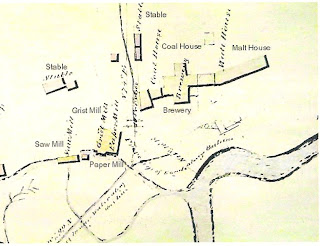Sarah's daughters, Mary and Elizabeth, married paper mill owners, Colin Skinner and John Eastwood, connecting Todmorden's businesses through family ties.
 |
| Sarah Lord Helliwell, 1775 - 1842 |
 |
| The Helliwell brewery was built into the hillside. |
The Don
Brewery operated for nearly thirty years, until it was destroyed by fire in
1847.
The Don Valley
provided an excellent environment for a brewery: the Don River powered the
brewery’s water wheel, driving its pumps and machinery, natural springs in the
hillside provided pure water for beermaking, and the steep ravine supported a
stepped foundation for the brewery’s gravity-fed processes and deep cellars.
 |
| A water wheel drove the rollers in the Don Brewery's malt mill. |
 |
| Todmorden, 1835, showing an extensive brewery. |
By 1830, the expanding Don Brewery dwarfed the nearby paper mill, and included a multi-story brewhouse, a distillery, a malthouse, and a grist mill. Todmorden’s malthouse stretched along the length of the hillside, measuring nearly 25 metres. A two- or three story stone house was also part of the complex. Several mills, farm buildings and stables stood nearby, and the brewery was surrounded by vegetable gardens, meadows, orchards and hops fields.
Beer is a
perishable product and before the days of year-round refrigeration, beermaking
was a winter time occupation, providing seasonal employment for farm hands
after the fall harvest. When in full operation, the Don Brewery employed 20 men
as maltsters, brewers and labourers. A typical working day in the brewery would
be 12 – 14 hours long, and some workers were required to live on site. Children
also worked here seasonally, in the autumn, as hops pickers.
 |
| The Helliwells shipped beer from their wharf at Market Street, Toronto |
 | |
| William and Joseph Helliwell, brewers. |
The Don
Brewery transported kegs of beer by horse-drawn wagon to the city centre. Thomas
Helliwell Jr. operated a wharf near St. Lawrence Market, and shipped beer
around the north shore of Lake Ontario. Todmorden also supplied the garrison at
Fort York, an active military site during the period, as well as many local
taverns and inns. Montgomery’s Tavern, made famous as a gathering point for the
1837 rebellion, was one of the Don Brewery’s customers.
The Helliwells also operated a distillery at Todmorden. Rye whiskey was its primary product.
 |
| Todmorden's brewery building served as a stables in the 1900s. |
After the fire
in 1847, the Taylor family acquired the brewery property and adjoined it to
their Brickworks operation, using the surviving structure as a stables and
storage building. Eventually the Don Brewery’s first story and cellars were landfilled
with debris from Brickworks kilns. Today’s brewery building represents only the top story of the original
structure.




















